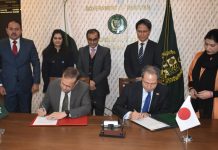By Ali Imran
ISLAMABAD: Provision of the healthcare services to the citizens at grassroots is the main pillar of a true welfare state and require enormous struggle to ensure well-being of citizens.
This task becomes more challenging especially at the time when a nation undergoes or comes across a challenge like Covid-19 as it has to tirelessly focus on efforts of building back communities. Pakistan was also not an exception to this situation but the government of the day diligently coped with this challenge and won appreciation across the globe by initiating prudent policies in this hour of turmoil. Pacing towards realization of the dream of making Pakistan as an Islamic Welfare state, the first-ever shock-oriented precision safety net “Ehsaas Tahafuz” was introduced by the PTI-led government under the internationally acclaimed Ehsaas Program.
Ehsaas Tahafuz is a flagship initiative of the government to provide one-time catastrophic health expenditures to the vulnerable populations and served around 1100 deserving patients so far.
Currently, the program is patient centric and caters to one-time high health costs for those who lack ability to bear the heavy expenditures while the enhancements are being planned to further expand its scale and scope in near future.
Ehsaas Tahafuz Project Management Unit was inaugurated at Holy Family Hospital (HFH) in the month of January for piloting this project while the Ehsaas Facilitation Desk was also established at the hospital to provide necessary guidance to the patients.
According to the Special Assistant to the Prime Minister on Poverty Alleviation and Social protection, Dr Sania Nishtar “Protecting vulnerable populations against catastrophic health expenditure is the main objective behind Tahafuz as catastrophic healthcare costs usually push people into extreme poverty”.
Ehsaas Tahafuz will work with public hospitals to identify patients facing catastrophic health expenditures, who will then be assessed by the system, and if eligible, will be provided funding by allocating donations to the patient.
The SAPM said that the people not availing any health insurance will just text the government to seek health aid to meet their catastrophic health expenditures and they will be assisted. “This will be our most effective program in the next few months”, she hoped.
The program has been developed on digital lines using information technology which provides immediate healthcare to deserving patients admitted in the hospital.
“Tahafuz is revealing the best results. This innovative fund-based program of health financing is contributing towards Universal Health Coverage (UHC) in Pakistan, a policy priority of our government to build back better, in a post COVID-19 context,” Dr Sania said.
Once fully operationalized nationwide, ‘Ehsaas Tahafuz will set up a one window paperless and web-based precision safety net. It will also have funders’ empowerment features in terms of micro transaction alerts and personalized login credentials for detailed web-viewing right down to the micro-transaction level.
As this unique initiative is proving to be a panacea to the miseries of poor people in the country, it is genuinely appreciated by the beneficiaries.
A mother of a beneficiary who visited HFH for treatment of her son said, “I came here from Mianwali. My husband runs a small shop. The doctors here told me about the free medical treatment facility under Ehsaas Tahafuz program.”
“I am thankful enough to the Ehsaas program team who have extended support to us in such a critical time”, she said.
Arshad from Pind Dadan Khan, Jhelum said, “My wife is admitted in the Intensive Care Unit (ICU) for the last four and a half months and I have spent my all savings on her treatment. Now I am relaxed that the Ehsaas Tahafuz team has taken the responsibility of her treatment”.
“It is my request to the Prime Minister, Imran Khan that this program should be continued and expanded”, he said.
The Ehsaas Tahafuz Steering Committee in its second meeting has approved various policy measures for expansion of Tahafuz Pilot project including beneficiary eligibility determination mechanism; treatment packages to be covered; and selection of service provider hospitals in line with program assessment criteria for expanding Tahafuz pilot.
The committee also deliberated on the ‘Ehsaas Catastrophic Health Expenditure Policy’ that is currently in the pipeline to dovetail Tahafuz with the Sehat Sahulat program of the government.
The Tahafuz Steering Committee has the mandate to provide managerial and strategic oversight to the Tahafuz program.
Recently, Ehsaas Tahafuz has also announced its policy to extend support to cancer wards across Pakistan where over 170,000 new cancer cases are reported every year.
According to estimates, cancer is responsible for the highest deaths in the Pakistani population, and the most common cause is inability of patients and their families to bear the catastrophic health expenditures.
“We have taken a principal decision to include cancer packages in Ehsaas Tahafuz. Cancer is the single commonest cause of catastrophic health expenditures.
Since cancer treatment is most expensive, Ehsaas Tahafuz is now ready to integrate cancer related packages in its scope of support”, the SAPM said.
The multi-faceted Ehsaas Program is running different segments including Ehsaas Kafaalat, Ehsaas Rashan Riayat, Ehsaas Undergraduate Scholarship Program, Ehsaas interest Free Loan Scheme, Ehsaas Amdan, Ehsaas Education Stipends, Ehsaas Rehriban Program, Ehsaas Nashonuma etc.
It is hoped that during days ahead this program would be expanded to benefit much more people deserving people in the country.






